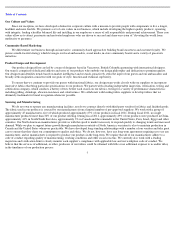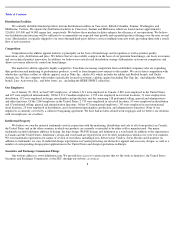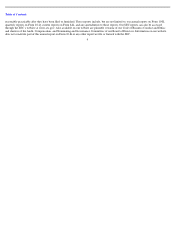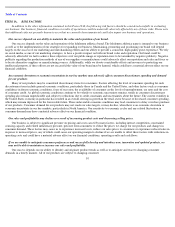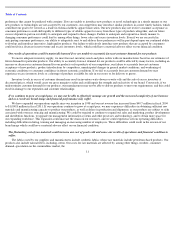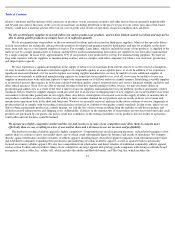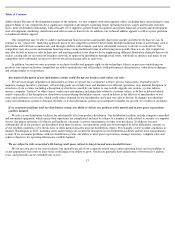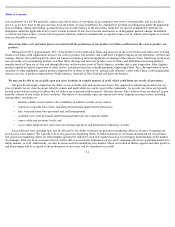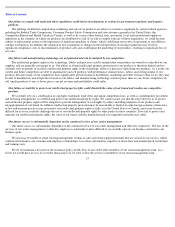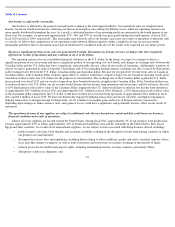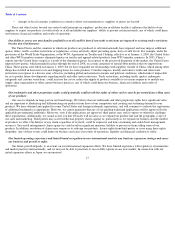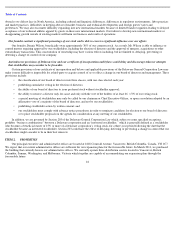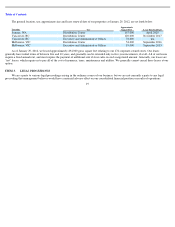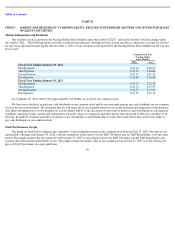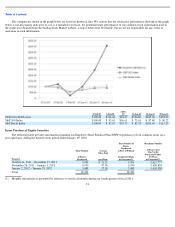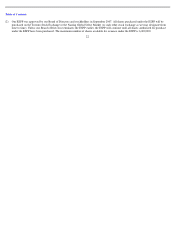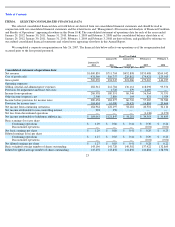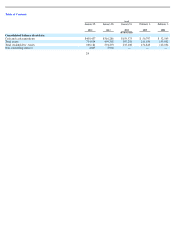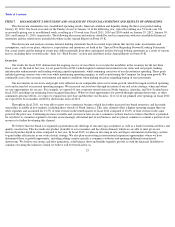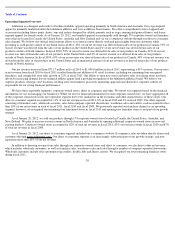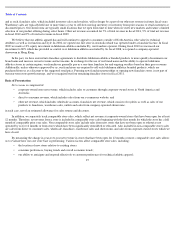Lululemon 2011 Annual Report Download - page 20
Download and view the complete annual report
Please find page 20 of the 2011 Lululemon annual report below. You can navigate through the pages in the report by either clicking on the pages listed below, or by using the keyword search tool below to find specific information within the annual report.
Table of Contents
These and other factors beyond our control could interrupt our suppliers’ production in offshore facilities, influence the ability of our
suppliers to export our products cost-effectively or at all and inhibit our suppliers’ ability to procure certain materials, any of which could harm
our business, financial condition and results of operations.
Our ability to source our merchandise profitably or at all could be hurt if new trade restrictions are imposed or existing trade restrictions
become more burdensome.
The United States and the countries in which our products are produced or sold internationally have imposed and may impose additional
quotas, duties, tariffs, or other restrictions or regulations, or may adversely adjust prevailing quota, duty or tariff levels. For example, under the
provisions of the World Trade Organization, or the WTO, Agreement on Textiles and Clothing, effective as of January 1, 2005, the United States
and other WTO member countries eliminated quotas on textiles and apparel-related products from WTO member countries. In 2005, China’s
exports into the United States surged as a result of the eliminated quotas. In response to the perceived disruption of the market, the United States
imposed new quotas, which remained in place through the end of 2008, on certain categories of natural-fiber products that we import from
China. These quotas were lifted on January 1, 2009, but we have expanded our relationships with suppliers outside of China, which among other
things has resulted in increased costs and shipping times for some products. Countries impose, modify and remove tariffs and other trade
restrictions in response to a diverse array of factors, including global and national economic and political conditions, which make it impossible
for us to predict future developments regarding tariffs and other trade restrictions. Trade restrictions, including tariffs, quotas, embargoes,
safeguards and customs restrictions, could increase the cost or reduce the supply of products available to us or may require us to modify our
supply chain organization or other current business practices, any of which could harm our business, financial condition and results of
operations.
Our trademarks and other proprietary rights could potentially conflict with the rights of others and we may be prevented from selling some
of our products.
Our success depends in large part on our brand image. We believe that our trademarks and other proprietary rights have significant value
and are important to identifying and differentiating our products from those of our competitors and creating and sustaining demand for our
products. We have obtained and applied for some United States and foreign trademark registrations, and will continue to evaluate the registration
of additional trademarks as appropriate. However, we cannot guarantee that any of our pending trademark applications will be approved by the
applicable governmental authorities. Moreover, even if the applications are approved, third parties may seek to oppose or otherwise challenge
these registrations. Additionally, we cannot assure you that obstacles will not arise as we expand our product line and the geographic scope of
our sales and marketing. Third parties may assert intellectual property claims against us, particularly as we expand our business and the number
of products we offer. Our defense of any claim, regardless of its merit, could be expensive and time consuming and could divert management
resources. Successful infringement claims against us could result in significant monetary liability or prevent us from selling some of our
products. In addition, resolution of claims may require us to redesign our products, license rights from third parties or cease using those rights
altogether. Any of these events could harm our business and cause our results of operations, liquidity and financial condition to suffer.
Our limited operating experience and limited brand recognition in new international markets may limit our expansion strategy and cause
our business and growth to suffer.
Our future growth depends, to an extent, on our international expansion efforts. We have limited experience with regulatory environments
and market practices internationally, and we may not be able to penetrate or successfully operate in any new market. In connection with our
initial expansion efforts in Japan, we encountered
17
•
changes in local economic conditions in countries where our manufacturers, suppliers or guests are located.


